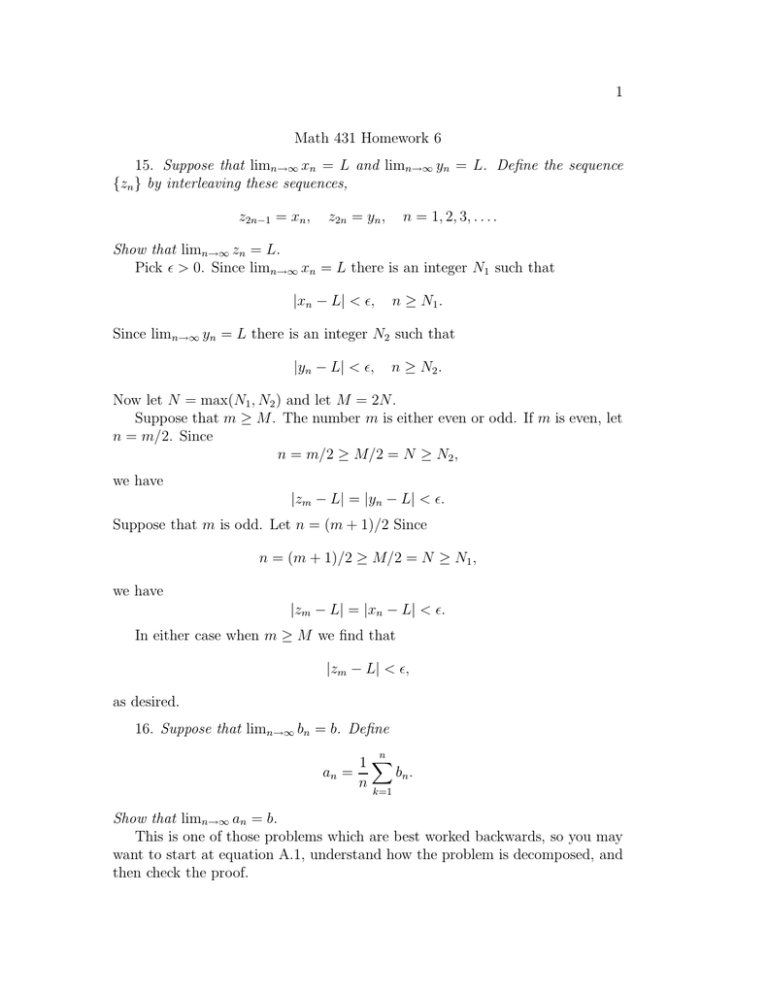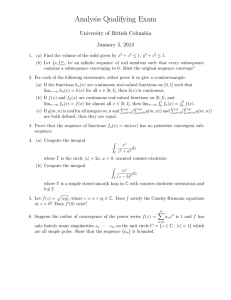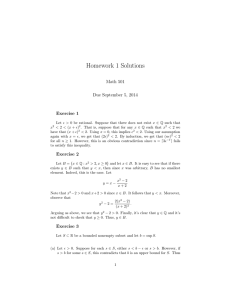1 Math 431 Homework 6 15. Suppose that limn→∞ xn = L and limn
advertisement

1
Math 431 Homework 6
15. Suppose that limn→∞ xn = L and limn→∞ yn = L. Define the sequence
{zn } by interleaving these sequences,
z2n−1 = xn ,
z2n = yn ,
n = 1, 2, 3, . . . .
Show that limn→∞ zn = L.
Pick ǫ > 0. Since limn→∞ xn = L there is an integer N1 such that
|xn − L| < ǫ,
n ≥ N1 .
Since limn→∞ yn = L there is an integer N2 such that
|yn − L| < ǫ,
n ≥ N2 .
Now let N = max(N1 , N2 ) and let M = 2N.
Suppose that m ≥ M. The number m is either even or odd. If m is even, let
n = m/2. Since
n = m/2 ≥ M/2 = N ≥ N2 ,
we have
|zm − L| = |yn − L| < ǫ.
Suppose that m is odd. Let n = (m + 1)/2 Since
n = (m + 1)/2 ≥ M/2 = N ≥ N1 ,
we have
|zm − L| = |xn − L| < ǫ.
In either case when m ≥ M we find that
|zm − L| < ǫ,
as desired.
16. Suppose that limn→∞ bn = b. Define
1X
bn .
n
n
an =
k=1
Show that limn→∞ an = b.
This is one of those problems which are best worked backwards, so you may
want to start at equation A.1, understand how the problem is decomposed, and
then check the proof.
2
Pick ǫ > 0, and let
ǫ1 = ǫ2 = ǫ3 = ǫ/3.
Since limn→∞ bn = b, there is an N1 such that
|bn − b| < ǫ1 ,
n ≥ N1 .
Since b1 + · · · + bN1 is a fixed number, there is an N2 such that
(b1 + · · · + bN1 )/n < ǫ2 ,
n ≥ N2 .
Finally, there is an N3 such that
bN1 /n < ǫ3 ,
n ≥ N3 .
We now take N = max(N1 , N2 , N3 ) and suppose n ≥ N. Then
Pn
b1 + · · · + bn
b1 + · · · + bN1 bN1 +1 + · · · + bn
k=1 bk
=
=
+
,
n
n
n
n
=
so
|
Pn
k=1 bk
n
A.1
b1 + · · · + bN1 (n − N1 )b (bN1 +1 − b) + · · · + (bn − b)
+
+
,
n
n
n
− b| < |
b1 + · · · + bN1
(N1 )b
(bN +1 − b) + · · · + (bn − b)
|+|
|+| 1
,
n
n
n
< ǫ1 + ǫ2 + ǫ3 = ǫ.
17. Suppose that S ⊂ R is a set with least upper bound L. Show that if L ∈
/S
then there is a strictly increasing infinite sequence xk ∈ S that converges to L.
Show by example that this result may be false if L ∈ S.
a) We showed in class that if L is the least upper bound for a set S, then
for any ǫ > 0 there is a point x ∈ S with x < L and such that L − x < ǫ. To
generate the desired sequence of points xk , let ǫ1 = 1, and pick x1 ∈ S such that
L − x1 < ǫ1 . Since L ∈
/ S we have x1 < L.
Now for k ≥ 2 define
ǫk = min(1/k, L − xk−1 ).
Pick xk ∈ S such that L − xk < ǫk . Since L ∈
/ S we have xk < L. Since
L − xk < L − xk−1 ,
we have xk > xk−1 . Thus the sequence {xk } is strictly increasing. Finally, since
L − xk < 1/k, we also have
lim xk = L.
k→∞
3
b) Suppose that S consists of a single point L. Then L is the least upper
bound for S, but S has no strictly increasing sequences. In fact any finite set S
will be a counterexample.
18. Suppose that A and B are subsets of R with least upper bounds L and M
respectively. Prove or give a counterexample:
a) The least upper bound of A ∪ B is the maximum of L and M.
This statement is true. Let T = max(L, M). First of all, if x ∈ A ∪ B then
either x ∈ A, in which case x ≤ L, or x ∈ B, in which case x ≤ M. In either
case x ≤ T = max(L, M), so T is an upper bound for A ∪ B.
To show that T is the least upper bound for A ∪ B, suppose that T = L; the
case T = M is handled similarly. Suppose that Q is an upper bound for A ∪ B
with Q < T . Since L is the least upper bound for A, there is some point x ∈ A
such that Q < x ≤ L = T . Since x ∈ A ∪ B, we have contradicted the assertion
that Q is an upper bound for A ∪ B. Thus T is the least upper bound for A ∪ B.
b) The least upper bound of A ∩ B is the minimum of L and M.
Suppose that A = [0, 1] ∪ [2, 3] and B = [0, 1] ∪ [4, 5]. Then the least upper
bound for A is 3, the least upper bound for B is 5, the minimum of the two is
3, but the least upper bound for A ∩ B = [0, 1] is 1.
20. Show that any sequence xk ∈ R has a monotone subsequence. (Hint:
Handle the cases when {xk } is bounded and {xk } is unbounded separately. If
{xk } is bounded it has a subsequence {xk(n) } converging to x0 . Either there are
infinitely many n with xk(n) ≤ x0 or infinitely many n with xk(n) ≥ x0 .)
Suppose first that the sequence {xk } is unbounded. Let y1 = x1 . Now for
each positive integer n > 1 there is a term yn = xk(n) such that |yn | ≥ |yn−1|.
The sequence {yn } either has an infinite subsequence which is positive, hence
increasing, or negative and decreasing.
Suppose now that the sequence {xk } is bounded. This sequence has a subsequence {yn } which converges to a number y0 . The sequence {yn } either has
an infinite subsequence which is ≥ y0 or an infinite subsequence which is ≤ y0 .
Let’s suppose that the first case holds, and let the subsequence be zm . Let
w1 = z1 , and for each positive integer j > 1 pick a term wj = zm(j) such that
wj−1 ≥ wj ≥ y0 . This is possible because if wj−1 = y0 then we can make all
subsequent choices equal to y0 , and if wj−1 > y0 then there is a wj−1 > wj ≥ y0 .
The sequence {wj } is the desired monotone (decreasing) subsequence.
22. Suppose that z1 , . . . , zK is a finite collection of real numbers. Construct
a sequence {xn } such that each zk is the limit of a subsequence of the sequence
{xn }.
The easiest way to do this is simply to interweave the zk ,
{xn } = z1 , . . . , zK , z1 , . . . , zK , z1 , . . . , zK , . . . .
4
To be more explicit, this sequence has the form
xk+mK = zk
for k = 1, . . . , K and positive integers m. To make a less tedious sequence,
simply take yn = xn + 1/n.
24. Show that a compact set is bounded.
Let’s show that an unbounded set cannot be compact. Suppose that U ⊂ R
is unbounded. Pick a sequence xn from U satisfying |xn | ≥ n. This sequence
has no convergent subsequence since any subsequence yk = xn(k) also satisfies
|yk | ≥ k, so the subsequence is unbounded, while any convergent sequence must
be bounded. Thus if U is not bounded, then U is not compact.
31. Show that the set R of real numbers is closed.
The point of this exercise is to show that the real numbers R = (−∞, ∞),
which is an open interval, is also a closed interval. This is not the case for open
intervals (a, b) with a, b ∈ R.
Looking at the definition on page 177, a point z ∈ R is a limit point of R if
there is a sequence {xk } with xk ∈ R and limk→∞ xk = z. The set R is closed
if it contains all its limit points. But all the limit points are real numbers by
definition. Thus R is closed.




